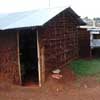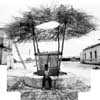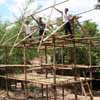RIBA ICE Bursary, innovative design projects prize, Building design property news
RIBA ICE McAslan Bursary : Call for Entries
Architectural Funding – 2012
RIBA ICE McAslan Bursary Call for Entries
The RIBA ICE McAslan Bursary, worth £7,500 and generously funded by John McAslan + Partners, will open to entries on Wednesday 2 May.
24 Apr 2012
RIBA ICE McAslan Bursary 2012
The RIBA ICE McAslan Bursary gives recognition to innovative design projects and supports the energy, talent and creativity of architecture and engineering students, graduates, newly qualified architects and engineers.
John McAslan:

photograph from RIBA
The winning individual or team will use the bursary fund to develop an original design project that will cultivate positive and real change for the environment and communities involved. The bursary has been running since 2005, and has supported 16 successful projects by architecture and engineering students and graduates, awarding almost £80,000.
RIBA President Angela Brady said:
“I’m delighted that John McAslan + Partners are continuing to support students and recent graduates and are offering such a generous bursary alongside invaluable mentoring support. The bursary is a fantastic opportunity to do something different, and create a potentially career transforming project. The winning team or individual will have the chance to design and deliver a truly unique project while working alongside one of the world’s leading architectural practices.
“I’m urging all students on RIBA or JBM-accredited courses and recent graduates to realise their dreams and apply for this life-changing bursary.”
John McAslan CBE, Executive Chairman + Founder of John McAslan + Partners said:
“We look forward to receiving submissions from architecture and engineering students and graduates, for whom the bursary offers an excellent opportunity to explore and develop their talents and interests. This is essentially a collaborative process and the aspiration is that our knowledge and experience will help support the realisation of the winning project.”
ICE President Richard Coackley said:
“One of the biggest challenges facing the built environment today is the ever pressing need to adapt and innovate, finding sustainable and new solutions to every day problems. We must therefore engage young people early in their career, encouraging them to think in unorthodox ways, and be ambitious and creative from the outset. This initiative is a marvellous example of industry working together to recognise young engineers with talent and vision.”
An exclusive event for potential applicants will be held on Wednesday 2 May (6 – 8.30pm) at the William Road Gallery at John McAslan + Partners, 7 – 9 William Road, London NW1 3ER. Potential applicants should visit the Education page on architecture.com to register their interest.
Previously:
29 Apr 2010
RIBA / ICE Bursary Winners
RIBA / ICE BURSARY AWARD WINNERS ANNOUNCED
Today, John McAslan + Partners and the whitbybird foundation announced this year’s RIBA / ICE Bursary Awards, which have been given to projects based in the UK and Kenya. The bursary aims to support architectural and engineering students, graduates and newly qualified architects and engineers committed to the progress of environmental and community issues in the UK or abroad.
The two award recipients were selected from a total number of 39 submissions by a panel of experts comprising RIBA and ICE members:
– A bursary of £9,500 is awarded to chartered civil engineer Yolanda Chakava towards her Kenya-based project, ‘Is a well really sustainable? – An engineer’s perspective to tackling Nairobi’s urban water crisis’, which aims to assess the sustainability and environmental impact of constructing well projects in the urban slums of Nairobi;
– A bursary of £5,000 is awarded to architects’ Melanie Bax and Sarah Considine towards a UK-based project ‘We ♥ the Suburbs’, which involves collaborating with the suburban community of St. Luke’s in Southend-on-Sea and culminates in a built form being constructed during the summer of 2010.
Yolanda Chakava + mud structure in Hoywik School, Kibera slum, Nairobi

Yolanda Chakava said, “It is an honour to receive the RIBA/ICE Bursary and to receive such positive recognition is hugely encouraging for my project. I believe that it is essential for engineers, NGOs and charities to devise a better way of implementing well projects in developing countries.
Having grown up in Kenya, it is evident to me that there are many well projects that rely on incredibly costly electricity, resulting in the end-users being charged ludicrous amounts of money for water. Additionally, the lack of long-term water management means that children are becoming sick because of water contamination. For this to happen to people with minimal means is totally unacceptable to me, so I hope that by implementing more sustainable strategies at the initial stages of these projects, we can better serve these communities.”
Well drilling, Galilee School, Kayole Slum, Nairobi

Melanie Bax and Sarah Considine commented, “We are absolutely delighted to receive a Bursary to support our ‘We ♥ the Suburbs’ project. Having grown up in the ‘burbs’ and subsequently lived in urban locations, it is apparent to us that more needs to be done to engage with suburban communities about where they live.
Most communities actually want a more direct cultural input into their environment – they don’t just want ideas imposed upon them. And, as our needs dramatically change over the next 50 years, it is clear that industry professionals will need to work much more closely with suburban communities to ensure that we build and regenerate in a more healthy and sustainable way, utilising local resources and being inspired by local cultures and history. Our first public consultation on the project starts this weekend and we can’t wait.”
Yolanda Chakava + well drilling equipment, Galilee School, Kayole Slum, Nairobi

John McAslan, chairman of John McAslan + Partners, said, “Mark Whitby from the whitbybird foundation and I are both delighted with the recipients selected to receive the RIBA/ICE Bursary. We feel that both Yolanda’s Kenyan project and Melanie and Sarah’s UK-based project are fresh ideas that demonstrate a significant commitment to making a positive impact on two very different communities. We very much look forward to seeing the end results.”
Ruth Reed, RIBA President, and Professor Paul Jowitt, President of the ICE, stated, “The RIBA and the ICE are committed to providing a valuable experience for emerging architects and engineers. This year’s RIBA/ICE Bursary recipients are both excellent examples of the kind of innovative and altruistic thinking that must be embraced if we are to meet the many challenges facing us in future.”
11 Dec 2009
RIBA ICE McAslan Bursary 2009
JOHN McASLAN + PARTNERS AND WHITBYBIRD FOUNDATION
COMMIT £100,000 TO THE RIBA/ICE BURSARY
AND ANNOUNCE NEW PARTNERSHIP WITH THE CLINTON GLOBAL INITIATIVE
John McAslan + Partners has committed to fund the RIBA/ICE Bursary for a further five-year period. Set up in 2004 between the practice, the Royal Institute of British Architects (RIBA) and the Institution of Civil Engineers (ICE), the bursary aims to support architectural and engineering students, graduates and newly qualified architects and engineers committed to the progress of environmental and community issues in the UK or abroad. This year, the whitbybird foundation is joining John McAslan + Partners (JMP) in committing £50,000 each over the next five years.
Shade Structure, Gujarat, India (Craig Bamford)

The new agreement also accompanies an important new development in the bursary. To date, students and recent graduates who apply for bursary funding have researched and proposed their own projects. Applicants will still be able do this, however, they will also be able to select from a shortlist of projects facilitated by the Clinton Global Initiative (CGI) – established by former US President Bill Clinton in 2004. In 2005, President Clinton established CGI to turn ideas into action and to help our world move beyond the current state of globalisation to a more integrated global community of shared benefits, shared responsibilities, and shared values.
“The Clinton Global Initiative is about solving the world’s pressing problems through sustainable business practices,” said Bob Harrison, CEO of the Clinton Global Initiative. “CGI is delighted to participate in the RIBA/ICE Bursary projects which will benefit communities in need and promote conservation.”
John McAslan, chairman of John McAslan + Partners, said, “Architecture and construction may be going through challenging times, but we feel it is vitally important that those of us who are in a position to, can use our expertise for good. The RIBA/ICE Bursary partnership with the CGI will provide valuable experience for winners of the bursary, whose fresh ideas we hope will help to solve some of the challenges communities around the world are facing. I’m also delighted to be able to welcome our new funding partner, the whitbybird foundation whose commitment and expertise will be invaluable.”
Mark Whitby, former chairman of whitbybird and a trustee of the whitbybird foundation, commented, “I am very pleased to be invited to join this important bursary; its contribution to the education of young architects and engineers over the past six years is significant. The students and graduates are able to propose new ideas for research and gain valuable practical experience working in-house. The collaboration with the CGI will provide important opportunities for the students to develop sustainable solutions for projects around the world.”
Ruth Reed, RIBA President, said, “We are delighted with John McAslan’s continued support of this important bursary, and welcome the new sponsorship from the whitbybird foundation and collaboration with the CGI, which I am sure will help this scheme go from strength to strength and enable more students and graduates to make a real difference to people’s lives.”
Professor Paul Jowitt, President of the ICE, said, “Never before has so much been expected of our professions in terms of international sustainable development and infrastructure. We must therefore ensure that our engineers and architects have the skills and knowledge to address the countless problems we are currently facing, providing young professionals who are early on in their careers with the opportunity to work on international projects in challenging locations.” Bursary application forms are available via the RIBA website: www.architecture.com
One Year House, Thai-Burma border (Asif Khan and Julia King)

Detailed information about eligibility criteria and the aims of the Bursary is contained within the application form.
Completed application forms should be posted to:
The RIBA ICE Bursary 2010, RIBA Education, 66 Portland Place, London W1B 1AD.
RIBA / ICE Bursary Haiti image / information received 101209
Location: London, UK
RIBA ICE Bursary Recipients Archive
Previous RIBA ICE Bursary Recipients from 2006 to 2008
Projects by previous Bursary recipients can be found at: http://www.mcaslan.co.uk/practice/winningprojects.php?y=2005# Below is a selection of three projects that Bursary winners have either designed or worked on:
2008 case study: Community Schools in Malawi
The prototype school design developed for CHDI (Clinton Hunter Development Initiative) by Hannah Lawson, director of the education and culture team at JMP; in collaboration with the Malawi Department of Education and DfID (Department for International Development), and Arup. Four prototype schools have now been constructed, and further prototypes are currently under construction. The Malawi Department of Education plans to roll out the final prototype design across Malawi from spring of next year. 2008 recipients of the Bursary, Asif Khan and Julia King, are currently designing a mass sustainability, zero carbon chair and school desk, which could potentially be used within the schools.
2007 case study: One Year House, Mae La Refugee Camp, Thailand-Burma border
Julia King and Asif Khan’s project seeks to improve mechanisms for addressing shelter in the Mae La refugee camp on the Thai-Burma border. Upon visiting the camp, Julia and Asif discovered a population of 50,000 people living in 10,000 houses forcibly dependent on NGO handouts, relying on building materials distributed in the same way as food rations. A further complication was that the Thai government does not allow permanent buildings to be constructed in the camps.
Collaborating with the carpenters in the camp, the camp committee, local and regional NGOs and consultation with the UN, Julia and Asif helped to build a versatile 1:1 prototype modular family house in the camp over one week, that addressed environmental and constructional issues. The key new developments were a flexible structural jointing system, developed by Julia and Asif, and an articulated roof ridge detail. Environmental assessments included lighting analysis tests on the roof system. The project, whose benefits may eventually spread to other Thai border refugee camps, was awarded follow-up funding by the British Council.
2006 case study: Shade Structure, Gujarat, India
Craig Bamford’s collaboration with Thuwavi involved the design and building of a shade structure, which acts as a communal gathering place. Shimakeldi village was moved from the fertile valleys of the Narmada river to the dry plains of Thuwavi 100 km north, due to the building of the Sardar Sarover dam and subsequent flooding of their ancestral land. Since then, life for the villagers has been a severe test of stamina; fertility has been replaced by subsistence. Working with villagers, Craig constructed a shade structure in the square to act as a meeting place for the community and a catalyst for further changes in the village. Several shade structures have each been built, each with a young tree planted within it, which in time will take over as shade and fruit providers.
John McAslan + Partners
John McAslan + Partners is a leading architectural and design practice, based in London, Manchester and Edinburgh, with a large portfolio of award-winning work in Britain and overseas. Encompassing urban design, infrastructure, commercial, residential, retail, education and the arts sectors, the practice has an outstanding track-record in transformational schemes involving culturally and historically significant buildings, including: the Grade I listed Modernist masterpiece, the De La Warr Pavilion at Bexhill on the South coast of England; the renowned Roundhouse arts venue in Camden, London; and the Grade II* listed Peter Jones department store in Sloane Square, London.
The practice is currently working on: the £450M development of the Grade I listed King’s Cross Station in the heart of London, the transformation of the historic centre of the Stanislavsky family in Moscow, including a prominent mixed-use and residential building; and new cultural and apartment buildings within the Heart of Doha project in Qatar. Having just recently completed the new British Embassy building in Algiers, the studio is currently working on a £120 million sustainable super-campus for Manchester Metropolitan University in Hulme; an innovative High School and Community Library at Craigmillar in Scotland, and a major new high quality office and mixed-use development near St Paul’s Cathedral in the City of London, known as 5 Cheapside.
In many of its projects, John McAslan + Partners – using up to 10% of its pretax profits and 1% of its billable time – has set up linked pro bono schemes to involve local young people, including the RIBA/ICE Bursary scheme. The practice is also working on a number of pro bono projects in partnership with the Clinton Global Initiative and other NGOs, including: the School of Genocide Studies in Kigali, Rwanda, as part of the world-renowned Kigali Memorial Centre; community schools and teacher training centres in Malawi, and a number of community, cultural and education projects in Haiti.
For more information, please visit: www.mcaslan.co.uk and www.mcaslan-family-trust.com
Royal Institute of British Architects
The Royal Institute of British Architects is the UK body for architecture and the architectural profession, providing support for 40,500 members worldwide in the form of training, technical services, publications and events. It also sets standards for the education of architects, both in the UK and overseas, and works with government to improve the design quality of public buildings, new homes and new communities.
The RIBA’s annual awards schemes recognise outstanding architecture and culminate in the RIBA Stirling Prize. At the Victoria and Albert Museum, the RIBA hosts exhibitions, archives, talks and shared study facilities in partnership with the V&A. From its London headquarters, the RIBA helps the public to learn more about the built environment through information services, websites and a library that includes an unrivalled collection of books, photographs and manuscripts.
Institution of Civil Engineers
The Institution of Civil Engineers (ICE) was founded in 1818 to ensure professionalism in civil engineering. It represents 80,000 qualified and student civil engineers in the UK and across the globe. The ICE has long worked with the government of the day to help it to achieve its objectives, and has worked with industry to ensure that construction and civil engineering remain major contributors to the UK economy and UK exports.
Clinton Global Initiative
For more information on the Clinton Global Initiative, visit www.clintonglobalinitiative.org
Comments / photos for the RIBA ICE McAslan Bursary 2012 page welcome
Website: RIBA McAslan Bursary

